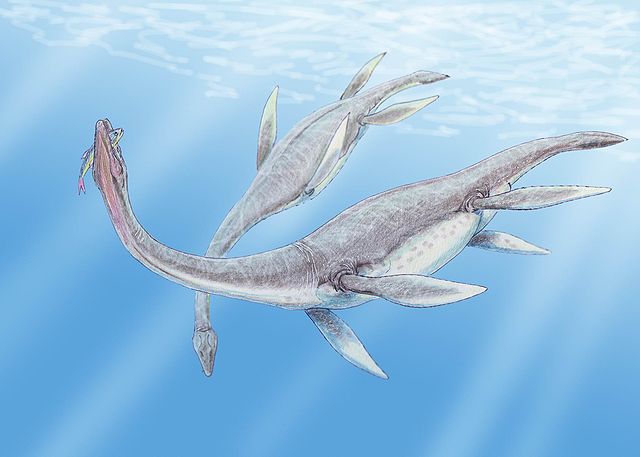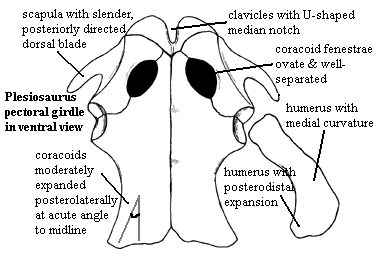Sauropterygia: Plesiosauroidea
Taxa on This Page
- Attenborosaurus X
- Plesiosauroidea X
- Plesiosaurus X
Plesiosauroidea

The plesiosauroids were sea-going reptiles with long neck and small heads filled with long sharp curved teeth. They had a flattened, barrel-shaped body and large paddle-shaped flippers. The two front flippers were always somewhat larger than the hind flippers. They ranged in size from 2.5 to 13 metres.
The plesiosauroids seem to have evolved during the Triassic, as supposed fragments occur in the Upper Keuper and Rhaetic of Europe. But it is only during the Early Jurassic that the group became well established. Beautiful skeletons are known from shallow marine deposits of Europe. Early Jurassic forms were generally quite small, about 3 meters in length, with a relatively short neck of about 32 vertebrae. As time progressed plesiosaurs developed longer necks and, by the middle Cretaceous, increased greatly in body size as well. The largest and most derived forms are known from the Late Cretaceous. These had long, snake-like necks and overall lengths of up to 13 meters. Ironically, the paddles are relatively smaller in these late forms then they were in the Jurassic types, indicating less emphasis on overall movement and more on capturing prey by stealth.
The long flexible necks enabled them to dart their small heads and catch fish in their toothy jaws. The neck became longer -- and perhaps more flexible with the addition of additional, shorter vertebrae -- as the group evolved through time. Plesiosauroids, unlike ichthyosaurs, used stomach stones for ballast to offset the buoyancy of their lungs. Plesiosauroids may have rested on the bottom, striking at prey with their long necks. Taylor (1981).
Plesiosaur classification has traditionally been a mess. One of the confounding factors has been the change in plesiosaur osteology during the course of development. As Brown (1981) notes:
Examples are known of plesiosauroid individuals ranging from half-grown to full-grown. Differences of osteological structure of specimens of a single species, attributable entirely to ontogeny, have in the past been misinterpreted and used to produce taxonomic divisions. This, together with misinterpretation of other characters used in taxonomy, has led to the publication of a hyperabundance of generic and specific names, and a proliferation of schemes of classification based upon these. In order to facilitate description and the study of ontogeny, specimens are here allocated to one of three categories which represent growth stages, as follows:
(i) 'Juveniles', in which the neural arches of the vertebrae are not fused to the centra;
(ii) 'Adults', in which fusion of neural arches and centra has taken place, and
(iii) 'Old adults', in which the neural arches and centra are fused, and in addition further characters of advanced ossification are found.
Image: Plesiosaurus dolichodeirus. ATW020706
Descriptions
 Attenborosaurus: Bakker 1993 A. conybeari (= Plesiosaurus conybeari) Sollas 1881.
Attenborosaurus: Bakker 1993 A. conybeari (= Plesiosaurus conybeari) Sollas 1881.
Range: Early Jurassic (Sinemurian) of Europe
Phylogeny: Plesiosauroidea : (Plesiosaurus + (Eretmosaurus + Sthenarosaurus + (Microcleidus + (Elasmosauridae + Cryptocleidoidea)))) + *.
Characters: 5 m total length; skull 10% (45 cm); snout long, massive and evenly tapered; tooth crowns very large & conical; neck very long; 36 cervical vertebrae; ~23 dorsals; 4? sacrals; caudals not recovered but estimated to be ~30; scapulae not in contact, with anterior support of pectoral girdle from clavicles (as in nothosaurs); coracoids relatively short; pubes short with rounded anterior ends.
Note: [1] The holotype was destroyed in the same bombing discussed at Sauropodomorpha) which destroyed the holotypes of Thecodontosaurus and Ctenacanthus, also housed in the Bristol City Museum. As in the case of Thecodontosaurus, a good cast was available. However, some information was irretrievably lost, as Sollas reported that some traces of integument were left on the fossil: the "thin brownish film...has nothing of the nature of scales and scutes, so far as we can see; it was a continuous membrane, not a collection of separate individual structures." However, small oblong bones were imbedded in the film in the pelvic region, and Sollas suggested "they may possibly be dermal plates." See Plesiosauria Translation and Pronunciation Guide.[2] The significance of this genus is that it has a relatively large, pliosaur-type skull, combined with a very long neck and a rather primitive pectoral girdle.
Links: Plesiosauria Translation and Pronunciation Guide; The Plesiosaur Site - Species. ATW020706
 Plesiosaurus: dela Beche & Conybeare 1821. P. dolichodeirus Conybeare 1824, P. guilelmiimperatoris Dames 1895.
Plesiosaurus: dela Beche & Conybeare 1821. P. dolichodeirus Conybeare 1824, P. guilelmiimperatoris Dames 1895.
Range: Early Jurassic (Sinemurian, possibly Toarcian) of Europe. One specimen possibly Late Triassic.
Phylogeny: Plesiosauroidea :: (Eretmosaurus + Sthenarosaurus + (Microcleidus + (Elasmosauridae + Cryptocleidoidea))) + *.
Characters: up to 3.5 m; head small; antorbital and temporal regions short; rostrum broad and pointed; pineal foramen prominent; parietals broad; sagittal crest present, sharp & narrow; jugal somewhat elongate; upper temporal fenestra circular; temporal bar narrow; cheek emargination weak; no real pterygoid flange; choanae placed almost directly below external nares; basicranium not covered by posterior expansion of pterygoids; mandibular symphysis not spatulate; 5 pairs of premaxillary teeth; ~24 pairs on dentary; teeth slender, pointed, homodont and without keels, round in cross-section; teeth ornamented with longitudinal ridges (?); neck long (150% body length) with ~40 cervical vertebrae; heads of cervical ribs separated by elongate longitudinal foramen (?); edges of centra articulations often rugose; prominent 'U'-shaped median notch at anterior of clavicular arch (for unossified interclavicle?); fenestrae (= coracoid foramina) of pectoral girdle are ovate and well-separated; scapula with a slender, posteriorly angled dorsal blade; coracoids moderately wide; "acute" (i.e. <45° from midline) angled posterolateral expansion of coracoids in adult; limbs narrow and very elongate; forelimbs slightly longer than hindlimbs (reversed in immature individuals); humerus with strong medial curvature in dorsal or ventral view; humerus with strong posterodistal expansion (entepicondyle?), but weak anterodistal corner (ectepicondyle?); humerus with interepipodial groove on distal end; robust, columnar anterior epipodials (radius & tibia) offset to extend beyond posterior epipodials (ulna & fibula); posterior epipodials crescentic; spatia interossea large and rhomboidal; 4 elements usually present in the proximal, 3 in the distal row of the carpus; 5 constricted metacarpals similar in form to phalanges; epipodials longer than broad; up to 9 phalanges in middle digit; digit IV longest; pubis large, slightly longer than ischium; pubis with generally convex anterior margin; puboischiadic fenestrae small, ovate to circular puboischiadic fenestra; pubis & ischium unfused across median bar; ilium with little twist to shaft; the fifth metapodial retained in the metapodial row.
Images: all images modified from Storrs (1997). See also Plesiosaur Skull Anatomy.
Notes: The Plesiosaurus, along with the Ichthyosaurus and the Pterodactyl (Dimorphodon) were among the first Mesozoic reptiles to be recognized. Many beautiful specimens were unearthed along the cliffs of Lyme Regis by Mary Anning. Because this was one of the first prehistoric reptiles to be named, it ended up as something of a taxonomic wastebasket, and a great many other Plesiosaur remains were also identified as Plesiosaurus. Hence most "Plesiosaurus" species do not belong to this genus at all, and in fact belong to different families altogether (or are simply too incomplete to be properly identified). Valid species lived during the Early Jurassic only.
Continued on Next Page ...
Using this material: All material by ATW is public domain and may be freely used in any way (also any material jointly written by ATW and MAK). All material by MAK is licensed Creative Commons Attribution License Version 3.0, and may be freely used provided acknowedgement is given. All Wikipedia material is either Gnu Open Source or Creative Commons (see original Wikipedia page for details). Other graphics are copyright their respective owners



 Plesiosaurus
Plesiosaurus

